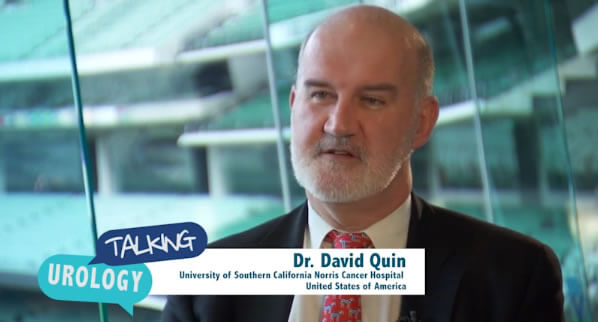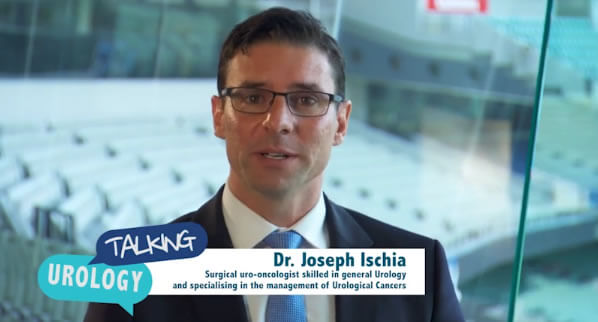USANZ 2017 – Dr Kevin McVary
Dr Kevin McVary, MD, FACS – Professor, Department of Surgery, Chair, Division of Urology, Southern Illinois University School of Medicine.
Joseph Ischia discusses the management of Benign Prostatic Hyperplasia management with Professor Kevin McVary.
Talking Urology podcast transcript
USANZ 2017 Interviews – Kevin McVary
This is Talking Urology.
Joseph Ischia: I’m Talking Urology with Kevin McVary who is a specialist in BPH and LUTS from the Southern Illinois University School of Medicine who gave an excellent talk today on the future directions of LUTS/BPH. Do we really need all this stuff? What were the highlights that you gave in your talk today?
Dr. Kevin McVary: Well, one of the focuses of my practice and Urology itself is where does the minimally invasive surgical treatment fit to what we already do, what’s called a MIST therapy, and I think it’s a controversial point because these are in some ways newer technology kind of busting their way in to our more traditional algorithm. One of the things I mentioned this morning was about why are patients and physicians attracted to these new technologies and my feeling is that they’re attractive because of the reduced risk of changes in sexual function. There is a cost when you have less risk and that’s that you probably have less impact. So, the things that a urologist may care about improving the symptoms, improving the flow with some low level but definite risk of change in sexual function is a bit of a tradeoff for a patient where he may accept not such robust outcomes if he can reduce his risk. So, balance, impact versus risk, and when patients do that they tend to choose less risk. So one of the things I think that drives this again is not what they do, it’s what they don’t do ,and they don’t impact sexual function.
Joseph: Your thoughts on the UroLift?
Kevin: Well, it’s a very innovative technique and for a NISH prostate, it’s got some distinct advantages. It improves symptoms and does not impact sexual function at least by every measure that we make. A downside is that probably a third of our patients don’t qualify because that middle lobe can be a problem. So that’s a potential negative although it is definitely attractive to patients and physicians are accepting it more and more each month. The real question with any minimally invasive therapy is, is it going to be durable. Now, we all went through the microwave techniques from a decade or so ago and then Prostiva, the TUNA device again a decade or so ago, and those therapies have been cast aside mostly because of the problem with durability. Those men tend to come back for more treatment and so we know that when you start to do MIST you have this risk, are you going to get the impact you want for the rest of that patient’s life and if you’re not then should you be using it at all. Patients would vote yes. They’re willing to take that risk but as urologists we’ve got to be honest with ourselves about is this going to be the last operation first or is this going to be an annuity program where every couple of years they come back and get a tune up.
Joseph: What are some of the new techniques or agents coming through?
Kevin: So, one in America that is catching on is convective vapor therapy, water vapor called Rezum, where you inject into the transition zone a small amount of steam, water converted steam, and it stays within the transition zone. That has a lot of versatility because if you inject it, it doesn’t travel into the peripheral zone, that’s what we care about when we treat BPH, and the anatomy of the prostate is almost not relevant because whatever you see on the day you do the procedure, you can treat it. You don’t have to screen outpatients in the sense that type of technique is more inclusive, so that’s an attraction. Now, it’s newer, it’s data is officially a year but the two-year data is very stable. But again we have to hold its feet to the fire to see is it going to be durable and again good impact as far as no change in sexual function. That’s very attractive to our patients. So, there is a very innovative idea about, it’s called Protox and it’s a fusion protein that is activated into apoptosis creating impact on the prostate and it’s activated by PSA. It’s really a cool idea. It takes about literally two minutes to do in the office. It is absolutely simple.
Joseph: Will it work?
Kevin: Well, the pilot studies we’ve done so far there is statistical improvement in symptoms and flow but you got to be careful with these kinds of injections because there’s a marked sham effect. And so, they were successful as a pilot, we need to do more studies so stay tuned, but just from a biology standpoint it’s a really cool concept.
Joseph: I’m going to throw some other treatments at you, ProArc.
Kevin: ProArc, well, I only know what I read and what I read is not so impressive. So, I’d say we need to stay tuned for that one.
Joseph: How about this one, prostatic artery embolization.
Kevin: Yes. So you know there’s a problem with that technique. I should say those studies, they’re poorly designed studies and there really aren’t good control groups so you’d really don’t know how are you really changing it for the man. I mean you always have to say this is an improvement compared to what. If you don’t have the right control group then the whole process falls apart and that’s the problem with our embolization. It’s that they’re not urologists doing the procedures. They really have not demonstrated an understanding of what drives lower urinary tract symptoms. In many of those studies, it’s like if you have a prostate we’re going to infarct it. Well we know that prostate is not the whole story on LUTS. In fact, it’s a fraction of it. LUTS is a much more complex problem. So what are you really treating when you’re embolizing, and guess what the PSA drops and then it comes back right back to where it used to be. To me, that says problem with durability.
Joseph: You had one very interesting point in your talk as well regarding the cost of waiting. So, watchful waiting versus early TURPs. I always thought if they didn’t have too much bother we didn’t need to worry.
Kevin: Yes. So the story on that is if you look at men who were randomized to TURP versus active surveillance and then they crossed back over from the active surveillance arm to the TURP, they don’t improve as much as the guys who had their early TURP. Now, that’s the problem. Now, this is supported when you look at the placebo group from big drug studies where they had long-term medical therapy like dutasteride, and when those men after a two-year period if they cross back over to active therapy to the real drug they don’t catch up to their peers. So that means there is a measurable impact with delaying effective treatment. The question is how big and what does it mean to a patient.
Joseph: And when they do need a TURP, you do monopolar TURPs?
Kevin: I stop monopolar TURPs a long time ago and the reason I did is a patient safety issue. The bipolar technology is definitely safer, it’s very versatile. I would say there are no disadvantages to total conversion to bipolar and leave monopolar around. It’s a little bit slower but what’s 10 minutes in a day.
Joseph: And what’s your preference, using a loop or a button?
Kevin: I use all the technologies and I use a button like I would a PVP. I use a button for a smaller gland where I’m trying to do it as outpatient procedure. When prostates get much bigger, 100 g and above, then I fall back to my old ways and I just use a loop because I feel like that’s a tougher anatomy, a tougher prostate to tackle, and I know I can get the job done if I do it with a loop and that’s opinion not fact.
Joseph: Thank you very much. It has been absolute pleasure, Kevin. I hope you enjoy your stay in Melbourne.
Kevin: Enjoyed it so much.
Joseph: Thank you.










